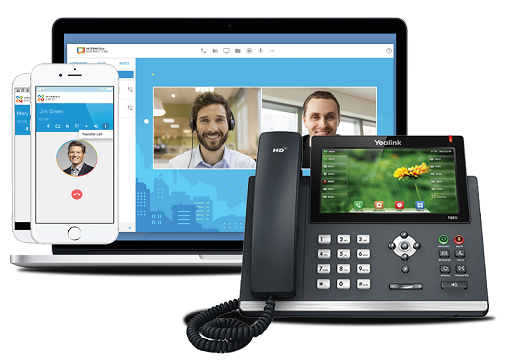Q&A with Intermedia: On Evolving Work Behavior and How Intermedia is Meeting the Changing Needs of the Modern Workplace

To say that today's workplace is very different from what it used to be ten years ago is an understatement. The world of work has significantly evolved over the past decades, and continues to be shaped by a number of factores--from various technological breakthroughs to the emergence of a new breed of workers.
And with these dramatic changes in the business landscape, it's safe to say that what worked then no longer works now. Thus, it has never been more important for organizations to learn to adapt quickly to new ideas, new business models, and most importantly, to new technologies in order to stay relevant and competitive.
In order to offer some insight into how technology is redefining the workplace, workday, and workforce, Intermedia, a leading cloud communications and collaboration provider to SMBs, commissioned a report that examines the evolving work behaviors of U.S. professionals.
VoipReview had the chance to speak with Mark Sher, the Vice President of Unified Communications, Product and Marketing at Intermedia, to discuss the findings of their 2018 Workplace Communications Report. Sher also shares how Intermedia continues to stay at the forefront of the increasingly competitive business communications market.
Q: Catch us up since we last spoke. What has Intermedia been up to? Any new solutions or developments you're particularly excited about at present?
 A: During our last conversation in early 2018, we talked about our newly unveiled UCaaS platform: Intermedia Unite. Since the launch, Unite has been very well received by our customers and partners. We’re continually adding new capabilities to it every month to ensure that it continues to exceed our customers’ expectations.
A: During our last conversation in early 2018, we talked about our newly unveiled UCaaS platform: Intermedia Unite. Since the launch, Unite has been very well received by our customers and partners. We’re continually adding new capabilities to it every month to ensure that it continues to exceed our customers’ expectations.
One specific update that I want to point out is the Softphone for the Intermedia Unite App, which was announced in June. Now, employees are empowered to use their desktop application as either a call controller for their associated desktop phone or as a softphone that allows them to place and receive calls on/from their computer. With 91% of SMBs supporting mobile employees—this provides them with tools that they need to work the way they want to.
Also, we’ll be sure to give you a heads up when we have more details to share about the updates to Unite, as well as some exciting new products that we have in the pipeline.
Q: In Intermedia’s recently released Workplace Communications Report, mobility and the rapid adoption of mobile applications are key trends that are changing the workplace. In your opinion, what factors have contributed to the expanding role of mobility in the workplace?
A: With millennials now making up the largest generation in the U.S. labor force and the gig economy estimated to grow to 43% by 2020, 9 to 5 jobs are becoming increasingly rare – especially among office workers. Many studies have shown that employees value flexibility and are demanding greater work/life balance, which in turn makes companies that offer the benefit of working remote extremely attractive.
Another influencing factor in the increase in mobility and rise in mobile application adoption is that organizations are becoming truly global. No longer are colleagues all located in the same office – you can have a meeting with a co-worker in China in the morning and then a sales meeting with a company in Brazil in the afternoon. While this is a trend that has been impacting organizations for many years, the rise in video conferencing technology has made it so that having a ‘face-to-face’ interaction doesn’t always require a plane ticket. Not only does this cut down on expenses for the company, but also leaves time for employees to work on other projects, while still making it home on time for dinner.
Q: When crafting a workplace mobility strategy, what should organizations consider and prioritize?
A: To create a mobility strategy that is welcomed rather than one that overwhelms, it is important to focus on offering a reasonable number of business applications that employees actually want, while delivering on a company’s realization that work doesn’t just happen from 9 to 5 anymore, nor just in the office. By doing so, adoption rates will be higher and the program will do its job – make employees more efficient and productive.
Q: Peace of mind, efficiency, and productivity are only some of the benefits that the respondents claim to enjoy by using mobile work applications. While the advantages of mobility cannot be denied, the ability to access business files and data on any device can also leave the company vulnerable to security risks. How can organizations help their teams reap the benefits of mobility without sacrificing enterprise security?
 A: Alongside the increased adoption of cloud and mobility technologies across enterprise environments, there is the employee expectation to have 24x7 access to web applications and data - anytime, anywhere and from virtually any device. However, if the appropriate steps are not taken, this can open up a company to vulnerabilities.
A: Alongside the increased adoption of cloud and mobility technologies across enterprise environments, there is the employee expectation to have 24x7 access to web applications and data - anytime, anywhere and from virtually any device. However, if the appropriate steps are not taken, this can open up a company to vulnerabilities.
While the specific security features that should be evaluated range depending on the solution you are purchasing, a key thing to look at is identity access management (IAM). This addresses the authentication and authorization management challenges associated with the way people work today because it’s device- and location-aware, and also enables cloud adoption through more flexible policies, which helps reduce risk, increase productivity, and maximize cost benefits.
Another key security incident all companies need to be aware of and prepared for are malware and ransomware attacks. When either strike, it can obviously be very disruptive to a business. Getting users back to working quickly depends on having the right applications in place (ones that address the rise in mobility utilization), so employee files are restored quickly.
Q: According to the report, video conferencing is also on the rise, with 75% of organizational leaders saying their work travel has been reduced due to expanded video conferencing capabilities. On the flip side, this growing use of video inside the enterprise also presents a new set of challenges for IT departments, especially that video can be bandwidth-intensive. What do you suggest to enable companies to efficiently support enterprise video initiatives?
A: While video has greater bandwidth requirements, in most cases, IT departments and network providers are aware that bandwidth heavy applications are continuing to grow in popularity and the network needs to be prepared. The most important thing IT can do is test their network, especially before any new implementation.
An additional consideration is Software Defined Wide Area Networking (SD-WAN). Intermedia recently announced that it selected Bigleaf Networks as a preferred provider of SD-WAN. SD-WAN provides another layer of assurance that networks will remain operating at optimum performance for real-time applications such as voice and video, with features that allow for intelligent load balancing and the ability to avoid dropped calls or other disruptions.
Q: Despite the popularity of new communication tools, it looks like email isn't going away, at least in the foreseeable future. Why do you think is this so?
A: Even with the rise of different communications tools, email has long stayed a constant. This is not surprising given it’s a tool that virtually everyone has access to – whether in paid or free form. Email is evolving in the fact that the tool is no longer just used to send and receive mail. For example, depending on the e-mail client, users are now able to one-click schedule and launch online meetings. Email is more and more becoming part of the overall unified communications mix.
Q: Intermedia’s Workplace Communications Report also reveals that respondents are highly interested in personal assistant apps and voice-activated tools for work. Does Intermedia have any new innovations in the pipeline that will potentially address this demand?
A: This is certainly on our 2019 radar and something we continually account for when building out our products.
Q: How competitive is the UCaaS market today? How is Intermedia continuing to stand out in the market?
 A: The UCaaS market is highly competitive – from pure plays to those that offer bundled offerings -there are lot of companies on the market. However, Intermedia continues to succeed and stand out from the competition by focusing on what our customers want and what we are good at, which includes developing and delivering products that are easy-to-use, deploy, and manage, and that enable greater efficiency, mobility, and productivity; products that are all supported by tremendous reliability, scalability, and security.
A: The UCaaS market is highly competitive – from pure plays to those that offer bundled offerings -there are lot of companies on the market. However, Intermedia continues to succeed and stand out from the competition by focusing on what our customers want and what we are good at, which includes developing and delivering products that are easy-to-use, deploy, and manage, and that enable greater efficiency, mobility, and productivity; products that are all supported by tremendous reliability, scalability, and security.
Plus, not every company targets the same group of customers – Intermedia, for example, plays strongly in the SMB market. We know that SMBs want affordable, all-in-one, and reliable products that get the job done, and so we have developed our UCaaS solutions to meet these unique needs. As mentioned earlier, to continue to meet our customers’ needs, we introduced Intermedia Unite – the all-in-one communications solution that brings together phone, chat, video, meetings, and file collaboration. It has been incredibly well-received, and we are thrilled that the UCaaS part of our business continues to grow.
Another thing that makes Intermedia different is that 80% of new business comes from partners. This is a testament to the fact that not only do we offers products that meet the end users’ needs, we are also meeting the needs of our more than 6,500 active partners – before, during and after the sale. Our Partner Program provides the flexibility to sell under the Intermedia brand or private label, a full library of brandable sales and marketing materials, a Partner Concierge Desk to assist in quoting and provisioning, handling billing and complex taxation issues for partners, just to name a name a few! Our partners are subsequently able to experience terrific margins – up to 50% – while not worrying about the admin and marketing support that frequently eats away at those margins.
About Intermedia
Intermedia is a Unified Communications as a Service (UCaaS) and business cloud email provider focused on delivering easy-to-use and secure communications and collaboration solutions to SMBs and the partners that serve them. More than 110,000 business customers and 6,500 active partners rely on Intermedia for greater reliability and productivity. Intermedia’s broad yet tightly integrated suite of cloud applications is managed through one intuitive point of control and is backed by a 99.999% uptime service level agreement (SLA). Intermedia’s offering includes cloud voice, web and video conferencing, content sharing, instant messaging, presence, file backup, sync and share, business email, identity and access management, and more.




